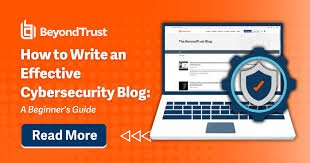How to Write a Secure Blog in 2025: Cybersecurity Best Practices for Bloggers
As blogging continues to thrive in 2025, so does the need for robust cybersecurity measures to protect both content creators and their audiences. Cyberattacks, data breaches, and hacking attempts are more sophisticated than ever, making it crucial for bloggers to implement best practices to secure their websites and safeguard sensitive data. Here’s how to write a secure blog in 2025, with essential cybersecurity tips that will protect your blog and build trust with your readers.
1. Choose a Secure Hosting Provider
The foundation of a secure blog starts with choosing the right hosting provider. Ensure that your hosting service offers robust security features such as SSL certificates, DDoS protection, and daily backups. Managed WordPress hosting options like WP Engine or Kinsta offer enhanced security features, including automatic malware scans, firewall protection, and server hardening, making them ideal for bloggers who prioritize security.
Why it’s crucial:
Your hosting provider is the first line of defense against cyber threats. A secure host minimizes the risk of server vulnerabilities and ensures that your blog’s data is safe from unauthorized access.
2. Implement SSL Encryption
In 2025, SSL (Secure Socket Layer) encryption is a must for every blog. SSL encryption protects the data transmitted between your website and visitors’ browsers by encrypting it. An SSL certificate will also display a padlock icon next to your blog’s URL, signaling to your visitors that their connection is secure.
Why it’s crucial:
SSL not only protects sensitive data, such as login credentials and payment information, but it also improves your search engine ranking. Google gives a ranking boost to websites with SSL certificates, so using SSL is both a security and SEO best practice.
3. Use Strong, Unique Passwords
Password security is a critical aspect of protecting your blog. Use long, complex passwords for your website’s admin panel and ensure that each account has a unique password. Tools like LastPass or Dashlane can help generate and store strong passwords securely, reducing the risk of password theft.
Why it’s crucial:
Weak passwords are one of the most common entry points for hackers. By using strong, unique passwords, you significantly lower the chances of unauthorized access to your blog and sensitive data.
4. Enable Two-Factor Authentication (2FA)
Two-factor authentication (2FA) adds an extra layer of security by requiring two forms of identification before accessing your blog’s backend. This typically involves entering your password and a one-time verification code sent to your phone or email. Enable 2FA for all your accounts associated with your blog, including your content management system (CMS) and email.
Why it’s crucial:
Even if a hacker manages to obtain your password, 2FA prevents them from accessing your account without the second authentication factor. This adds an additional layer of defense against account compromises.
5. Keep Your Software Updated
Regularly updating your blog’s software, including your content management system (CMS), plugins, and themes, is essential for maintaining security. Outdated software is a prime target for cybercriminals, as it may contain known vulnerabilities that can be exploited. Enable automatic updates wherever possible, and always check for updates after significant releases.
Why it’s crucial:
Security patches are often released to address vulnerabilities discovered in software. Keeping everything up to date ensures that your blog remains protected from known threats and reduces the risk of exploitation.
6. Back Up Your Blog Regularly
A comprehensive backup strategy is a crucial part of your blog’s cybersecurity. Regular backups ensure that you can quickly restore your blog if it is hacked or compromised. Use plugins like UpdraftPlus or BlogVault to schedule automatic backups to cloud storage or external servers.
Why it’s crucial:
In the event of a cyberattack, having a recent backup allows you to recover your data without losing valuable content or causing significant downtime. Regular backups help mitigate the impact of a potential security breach.
7. Limit User Permissions
Not everyone who has access to your blog’s admin panel should have full permissions. Limit user access to the minimum level necessary to perform their job. For example, content creators may only need access to the content editor, while administrators should have full access to the backend.
Why it’s crucial:
Limiting permissions helps prevent unauthorized users from making changes to your site or accessing sensitive data. In case of a breach, limiting access minimizes the damage caused by compromised accounts.
8. Install a Web Application Firewall (WAF)
A Web Application Firewall (WAF) helps protect your blog from common cyberattacks like SQL injection, cross-site scripting (XSS), and brute force attacks. A WAF acts as a barrier between your blog and potential threats, filtering out malicious traffic before it reaches your server. Services like Cloudflare or Sucuri offer WAFs tailored to protect blogs from a variety of threats.
Why it’s crucial:
A WAF enhances your blog’s security by blocking malicious traffic in real-time. This adds an additional layer of protection against hacking attempts and malware infections, preventing damage before it occurs.
9. Secure Your Admin Area with IP Whitelisting
To further secure your blog’s admin area, consider restricting access by IP address. This method allows only specific IP addresses to log in to the backend of your blog, blocking access from unknown or untrusted sources. This can be configured through your hosting provider or with a plugin for WordPress users.
Why it’s crucial:
IP whitelisting makes it much harder for hackers to gain access to your admin panel. Even if a hacker has your login credentials, they would still need to access your server from a trusted IP address.
10. Monitor Your Blog for Suspicious Activity
Constant vigilance is key to cybersecurity. Regularly monitor your blog for any suspicious activity, such as unauthorized login attempts, unusual traffic patterns, or changes to content. Plugins like Wordfence or Sucuri Security offer real-time monitoring and alert you if something seems off.
Why it’s crucial:
Early detection of suspicious activity helps you respond to potential threats before they escalate. Proactive monitoring can prevent minor issues from turning into significant security breaches, saving you time and resources.
11. Educate Your Team on Cybersecurity Best Practices
If you have a team of writers, editors, or other contributors, it’s essential to educate them about cybersecurity best practices. Encourage them to use strong passwords, enable 2FA, and be cautious about phishing attacks. Regular training ensures that everyone involved in your blog is aware of the potential risks and how to avoid them.
Why it’s crucial:
Your team is the first line of defense against cyber threats. Educating your team helps create a culture of security and ensures that everyone is aware of the steps they need to take to protect your blog from potential attacks.
Conclusion
In 2025, maintaining a secure blog is not optional — it’s a necessity. Cybersecurity threats continue to evolve, and bloggers must stay proactive in protecting their content, data, and readers. By following these best practices — from choosing a secure host to implementing strong authentication methods — you can ensure that your blog remains safe from potential cyber threats. By securing your blog, you’ll not only protect your valuable content but also build trust with your audience, keeping them engaged and confident in your brand.

